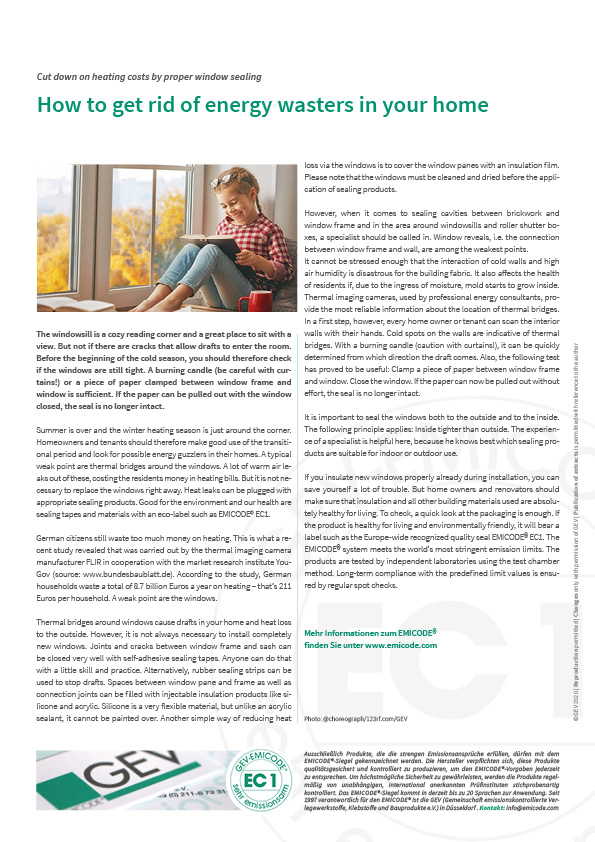How to get rid of energy wasters in your home
Cut down on heating costs by proper window sealing
Summer is over and the winter heating season is just around the corner. Homeowners and tenants should therefore make good use of the transitional period and look for possible energy guzzlers in their homes. A typical weak point are thermal bridges around the windows. A lot of warm air leaks out of these, costing the residents money in heating bills. But it is not necessary to replace the windows right away. Heat leaks can be plugged with appropriate sealing products. Good for the environment and our health are sealing tapes and materials with an eco-label such as EMICODE© EC1.
German citizens still waste too much money on heating. This is what a recent study revealed that was carried out by the thermal imaging camera manufacturer FLIR in cooperation with the market research institute YouGov (source: www.bundesbaublatt.de). According to the study, German households waste a total of 8.7 billion Euros a year on heating – that’s 211 Euros per household. A weak point are the windows.
Thermal bridges around windows cause drafts in your home and heat loss to the outside. However, it is not always necessary to install completely new windows. Joints and cracks between window frame and sash can be closed very well with self-adhesive sealing tapes. Anyone can do that with a little skill and practice. Alternatively, rubber sealing strips can be used to stop drafts. Spaces between window pane and frame as well as connection joints can be filled with injectable insulation products like silicone and acrylic. Silicone is a very flexible material, but unlike an acrylic sealant, it cannot be painted over. Another simple way of reducing heat loss via the windows is to cover the window panes with an insulation film. Please note that the windows must be cleaned and dried before the application of sealing products.
However, when it comes to sealing cavities between brickwork and window frame and in the area around windowsills and roller shutter boxes, a specialist should be called in. Window reveals, i.e. the connection between window frame and wall, are among the weakest points.
It cannot be stressed enough that the interaction of cold walls and high air humidity is disastrous for the building fabric. It also affects the health of residents if, due to the ingress of moisture, mold starts to grow inside. Thermal imaging cameras, used by professional energy consultants, provide the most reliable information about the location of thermal bridges. In a first step, however, every home owner or tenant can scan the interior walls with their hands. Cold spots on the walls are indicative of thermal bridges. With a burning candle (caution with curtains!), it can be quickly determined from which direction the draft comes. Also, the following test has proved to be useful: Clamp a piece of paper between window frame and window. Close the window. If the paper can now be pulled out without effort, the seal is no longer intact.
It is important to seal the windows both to the outside and to the inside. The following principle applies: Inside tighter than outside. The experience of a specialist is helpful here, because he knows best which sealing products are suitable for indoor or outdoor use.
If you insulate new windows properly already during installation, you can save yourself a lot of trouble. But home owners and renovators should make sure that insulation and all other building materials used are absolutely healthy for living. To check, a quick look at the packaging is enough. If the product is healthy for living and environmentally friendly, it will bear a label such as the Europe-wide recognized quality seal EMICODE® EC1. The EMICODE® system meets the world’s most stringent emission limits. The products are tested by independent laboratories using the test chamber method. Long-term compliance with the predefined limit values is ensured by regular spot checks.

Photo: choreograph/123rf.com/GEV
The windowsill is a cozy reading corner and a great place to sit with a view. But not if there are cracks that allow drafts to enter the room. Before the beginning of the cold season, you should therefore check if the windows are still tight. A burning candle (be careful with curtains!) or a piece of paper clamped between window frame and window is sufficient. If the paper can be pulled out with the window closed, the seal is no longer intact.

Do You Have Questions?
If you have any questions on certain topics or want to contact us for another reason, please contact us by phone or email.
Phone: +49 (0)211 843 449 – 01
info@emicode.com
Share article on Social Media:
